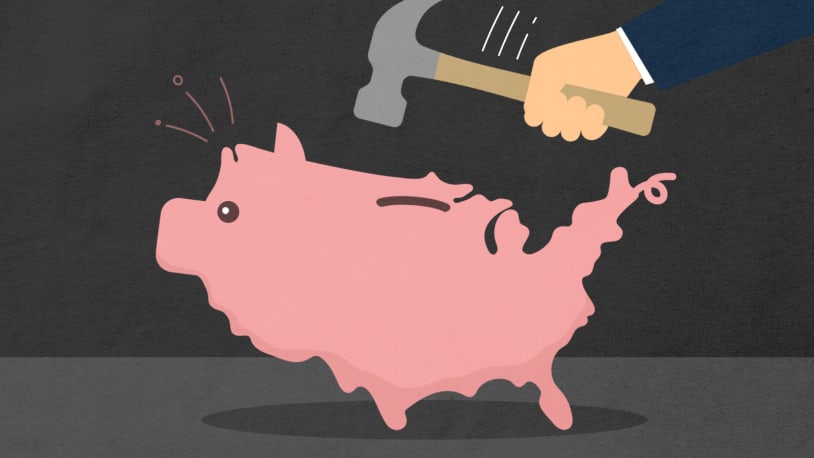
The right answer to high debt isn’t austerity. It’s abundance.

February 6, 2022
February 6, 2022
Every morning, around 8:30 a.m., a staffer texts Sen. Joe Manchin (D-W.Va.) with the current amount of the national debt. On Wednesday, the total crossed $30 trillion for the first time — a number more than twice what it was when Republican Paul Ryan was predicting that the “debt crisis” would be the most important topic of the 2012 elections, and roughly six times what it was when President Bill Clinton declared that the era of big government was over.
Yet here we are. We suffered the most severe recession since the Great Depression and the worst pandemic since 1918, massively expanded the debt to sustain our economy, and there has been no crisis. So is Manchin worrying for nothing? Or is it actually time to worry about the debt again?
The answer, as is so often the case with big economic questions, isn’t entirely clear.
Sovereign debt is very different from household debt or the debt incurred by states and localities, because the federal government borrows in a currency that it controls. That means there are effectively no short-term limits on how much the government can borrow, because if it needs money, it can always print it. But the United States is nowhere near the point where it “needs” money that sense. The markets for U.S. treasuries are the deepest in the world, and for that reason are the basis upon which a host of other financial assets are priced.
So the United States has no reason to worry about the kind of debt crises that countries like Argentina or Russia — which borrowed enormous sums in foreign currencies — faced in the past. But that doesn’t mean we face no limits at all. Discerning where precisely those limits lie, though, is as much crystal ball gazing as science.
At one extreme limit lies hyperinflation. When a country monetizes its debt — that is to say, when it sells new debt to its central bank rather than in the market — it is directly coordinating monetary and fiscal expansion and avoiding the discipline of public auctions. The risk in doing this is that those markets will see that avoidance as the true purpose of coordination, that monetary policy has now been placed in service of fiscal indiscipline. That would mean monetary policy could no longer be used to check inflation without triggering a sudden fiscal crisis — and the anticipation that inflation would not be controlled is precisely what would spark an inflationary spiral. The end of that road is the destruction of much private savings and finally economic collapse.
Alarmingly, we know very little about just how to spot hyperinflation in its early stages. But with Federal Reserve officials talking with increasing firmness about raising rates and shrinking the central bank’s balance sheet, that risk seems extremely remote. Even in its most expansionary phase, monetary policy was never tasked with facilitating fiscal expansion; rather, fiscal and monetary policy were working together to prop up an economy in free-fall. Today, any fiscal expansion would trigger a more severe monetary contraction, which is precisely why new spending is no longer a free lunch. For the same reason, though, a hyperinflationary spiral should also be off the menu.
There are other limits, however — or, rather, other potential ill effects from too-high debt. If domestic savings is inadequate to finance a growing debt, then an increasing percentage of public debt will come to be held abroad. That would mean a larger and larger percentage of national income will be sent abroad as interest; it would also mean a growing trade deficit (because a fiscal surplus must be matched by a trade deficit) and would make America’s fiscal position more vulnerable to decisions by foreign central banks.
But America’s personal savings rate actually exploded during the pandemic, rising from a base that was already significantly higher than the abysmally low levels of the 2000s. The percentage of public debt held by foreigners has been dropping as well. A bigger concern might be the distributional effects of high deficits, since domestic savings skews very strongly toward the wealthy, as well as toward retirees. As long as interest rates remain relatively low, however, the political and economic effects of these transfers should remain muted.
That “if,” though, points to the most obvious risk we face from our large debt: Even if an enormous debt can readily be refinanced, interest must be paid. Currently, that interest cost as a percent of GDP is relatively low — about half of what it was at its peak in the early 1990s and only modestly higher than what it was in the early 1950s. But if interest rates were to rise significantly, that cost could balloon. If that happened, either taxes would have to rise or other federal spending would have to be cut, or else we would wind up borrowing more simply to pay the interest on our previous borrowing — digging a deeper and deeper hole.
If you want to paint a plausibly worrisome scenario, then, it would look something like the following. To check inflation, the Federal Reserve would raise rates and shrink its balance sheet and persist in that policy over time to restore confidence in its ability to achieve its aims. Higher rates would drive up the cost of rolling over federal debt as it comes due but would also slow the economy, thereby squeezing the budget from both ends. Unlike in the 1980s, monetary contraction couldn’t be offset with fiscal expansion; unlike in the 1990s, fiscal retrenchment couldn’t be offset by looser money. Instead, the economy would wind up trapped between a rock and a hard place, with little policy room to maneuver.
How likely is that scenario? It’s impossible to say for sure — and there are a lot of ways things could go better. Inflation might turn out to be transitory and pandemic-related after all, and the current robust recovery might prove to have considerable legs. The Fed might be able to shrink its balance sheet without long rates backing up significantly, so interest costs could remain quite moderate. In that case, we’d have plenty of policy room for new spending, notwithstanding the high nominal amount of debt.
If we want to improve our odds, though, the most important thing to focus on is sustaining economic growth. Our federal debt as a percent of GDP reached uncharted territory during the pandemic, but that ratio has been coming down with economic recovery even as the debt has continued to grow. Policies that can extend and broaden that recovery in a fiscally neutral manner — through regulatory reform, productive investment offset by tax increases, and an immigration and child welfare agenda that encourages demographic expansion — would improve the debt situation directly by increasing federal receipts and indirectly by spreading the burden of servicing the debt over a larger economy.
The right answer to high debt isn’t austerity. It’s abundance.
February 6, 2022 February 6, 2022 Every morning, around 8:30 a.m., a staffer texts Sen. Joe Manchin (D-W.Va.) with the current amount of the national debt. On Wednesday, the total crossed $30 trillion for the first time — a number more than twice what it was when Republican Paul Ryan was predicting that the “debt crisis”…
February 6, 2022 February 6, 2022 Every morning, around 8:30 a.m., a staffer texts Sen. Joe Manchin (D-W.Va.) with the current amount of the national debt. On Wednesday, the total crossed $30 trillion for the first time — a number more than twice what it was when Republican Paul Ryan was predicting that the “debt crisis”…